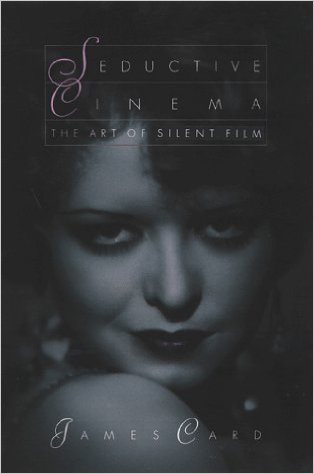 James Card was a witness to those early years of cinema when no one spoke, a “talkie” was a stage play, and stars reigned supreme because they had faces. His book is not scholarly exactly, but it is the sort of firsthand, eye-witness account which is too rare in the medium of film. While most film historians can essentially only retell what they have read or been told, Card is in the position of sharing what he saw with his own eyes. As he notes in the forward: he is a dying breed. Throughout the book, Card questions and outright denies much of the academic thought regarding film history, and he does this with such a flippant attitude that one can almost hear him say: I was there! Why are you arguing with me?
James Card was a witness to those early years of cinema when no one spoke, a “talkie” was a stage play, and stars reigned supreme because they had faces. His book is not scholarly exactly, but it is the sort of firsthand, eye-witness account which is too rare in the medium of film. While most film historians can essentially only retell what they have read or been told, Card is in the position of sharing what he saw with his own eyes. As he notes in the forward: he is a dying breed. Throughout the book, Card questions and outright denies much of the academic thought regarding film history, and he does this with such a flippant attitude that one can almost hear him say: I was there! Why are you arguing with me?
The first major target of his historical dismantling is the great D. W. Griffith, the famous and highly regarded director of The Birth of a Nation (1915). Card favors the view that there were many other films which were released both previous and contemporaneous to The Birth of a Nation, which far surpass it both in technical and narrative complexity. This was very refreshing for me, as I’ve held this same opinion for sometime but been unable to find much in the way of any books which agreed with me. What changed my mind was seeing Cabiria (1914, dir. Giovanni Pastrone), which was produced the year previous to Griffith’s “crowning achievement” as some (see: most) call it.
But there is so much more to silent film than D. W. Griffith, and it doesn’t take Card very long at all to begin exploring these areas and aspects of film. He breaks this up with many small anecdotes regarding his time a film collector and even his time working as a curator at a film archive and museum. “Seductive Cinema” is at its best when Card shares his first hand knowledge and experiences during the silent era (he was just a young boy who fell in love with movies, became a collector, then an archivist, and eventually a historian). One such passage is when he goes to great lengths to dispel the 16 frames per second myth that so often plagues silent films. The example he gives is Douglas Fairbanks Robin Hood (1922, dir. Allan Dawn), which, when shown at the frame rate intended by Fairbanks and its director, runs just slightly over 2 hours, but when shown at 16 frames per second runs over 3 hours. That’s a remarkable difference and more than enough shows why silent films are so often met with strange looks, suspicion, and avoidance: they are usually shown at the wrong speed. If a silent film is shown too slowly, an exciting swashbuckler like Robin Hood becomes a bore. If shown too fast then Metropolis (1927, dir. Fritz Lang) becomes a comedy. But if shown at the correct speed then the Little Tramp in The Kid (1925, dir. Charlie Chaplin) is transformed into the most brilliantly tragic and endearingly comedic character to ever grace the silver screen. These bits of information are what I enjoyed most about this book. It takes missteps and meanders through some of its subject for too long, but for the majority remains an engaging book about a most important and oft over-looked time period in the history of cinema.
Yet while its middle portions often seem to run too long — when they could have easily been broken into smaller sections to help with flow and readability — its final chapters run too short, leaving the reader with a hunger for more. The final chapter of the book, wherein Card discusses the future of silent cinema (and why it is so darn seductive) is possibly the best in the whole book but runs only a few short pages. “Seductive Cinema” is a wonderful book that gives terrific insights into the world of predialogue films. Card takes his time to dispel some of the greater myths remaining from that era (particularly the Kingship of D.W. Griffith), and then carefully reveals hidden gems, secrets, and stories to remember and reflect upon. There are a great number of films discussed in this book, and some will be worth looking for while others will not. But it is the first-hand knowledge of the working of silent films and the joy of watching silent films that makes this book rewarding.
Discussion
No comments yet.